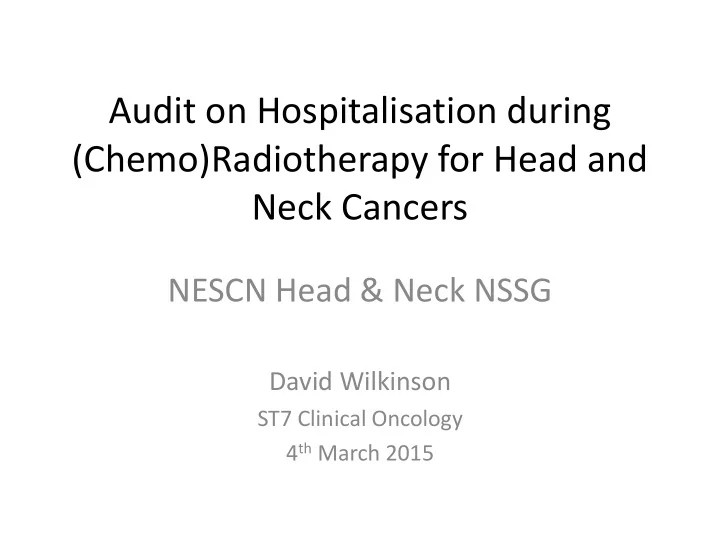

Audit on Hospitalisation during (Chemo)Radiotherapy for Head and Neck Cancers NESCN Head & Neck NSSG David Wilkinson ST7 Clinical Oncology 4 th March 2015
Background • CRT & RT can cure inoperable H&N cancer • It also causes significant side-effects which can put the patient at risk and compromise treatment efficacy • In the network, different approaches are taken to supportive management (feeding) • We aim to deliver radical radiotherapy as an outpatient
Aims 1. To gain knowledge of admission rates for patients undergoing treatment 2. To identify variations across the NECN 3. To analyse factors affecting any variation and share good practice
Standard of Care Evidence of Quality Standard Exceptions 100% Chemoradiotherapy for None head and neck cancer is given on an outpatient basis
Methods • Time Period: 4 months – 1 st September to 31 st December 2014 • First Audit • Prospective • Identification of patients admitted during radical dose radiotherapy or concurrent chemo- radiotherapy • Data Collection Form • Case note & IT systems review • Excel Spreadsheet • Simple Statistical Analysis
Results 1. Patient demographics 2. Disease characteristics 3. Systemic treatment history 4. Radiotherapy history 5. Admission patterns 6. Feeding history 7. Radiotherapy numbers 8. Admission rates 9. Other observations
Patient demographics Number of patients admitted NCCC 15 SRH 3 JCUH 7 DMH 1 N Tees 1 TOTAL 27 Age (years) Median 57 Range 34 - 76 Gender Male 16 (59%) Female 11 (41%) Co-morbidities Yes 17 (63%) No 10 (37%)
Disease characteristics Cancer site Nasal cavity/Paranasal sinus 1 (4%) Nasopharynx 3 (11%) Oral cavity 1 (4%) Oropharynx 12 (44%) Unknown primary 3 (11%) Hypopharynx 3 (11%) Larynx 4 (15%) Stage groupings I 3 (11%) II 1 (4%) III 4 (15%) IV 19 (70%)
Systemic treatment history (Chemo)radiotherapy Adjuvant 5 (19%) Definitive 22 (81%) Concurrent treatment 22 (81%) Radiotherapy alone 5 (19%) Concurrent regime Cisplatin 19 (86%) Cetuximab 3 (14%) Number of cycles Median 4 Range 0 - 5
Radiotherapy history Number of radiotherapy fractions planned 20 3 (11%) 30 24 (89%) Number of radiotherapy fractions pre-admission Median 16 Range 2 - 28
Admission patterns Inpatient duration (days) Median 11 (1 – 35) NCCC/SRH 9 (1 – 18) JCUH/DMH/NTH 15 (1 – 35) Most common reasons for admission NG/J insertion or poor oral intake 10 Chest infection 8 Nausea/Vomiting 6 Pain control 5 Mucositis 5 Nutritional support 4 Confusion 2 Other 8
Feeding history NCCC SRH JCUH NTees DMH TOTAL Oral 3 2 2 1 0 8 NG 10 0 0 0 0 10 PEG 2 1 5 0 1 9 TOTAL 15 3 7 1 1 27 71% PEG fed at JCUH 67% NG fed at NCCC
Radiotherapy numbers By cancer centre Total number definitive (chemo)radiotherapy NCCC 73 JCUH 49 Total number palliative radiotherapy NCCC 20 JCUH 4
Admission rates By cancer centre NCCC Number 18 Total 73 Rate 25% JCUH Number 9 Total 49 Rate 18%
Admission rates by Cancer Centre JCUH NCCC 0 5 10 15 20 25 30 Percentage (%)
Some other observations • Post-radiotherapy admissions • Palliative admissions Not original objective, but patients admitted after RT & palliative patients were recorded.
Post-radiotherapy admissions Site Oral NG/J PEG TOTAL NCCC 0 7 1 8 JCUH 0 1 1 2 SRH 5 0 0 5
Palliative admission during/after radiotherapy Site Number NCCC 4 SRH 1 JCUH 0
Summary Factor Fact Other information Most common tumour Oropharynx 44% Most common stage IV 70% Concurrent treatment 81% 86% Cisplatin Median No. fractions pre- 16 Wide range admission Median inpatient duration 11 nights 9 in North; 15 in South (but wide range) Most common reasons for 1. NG insertion/poor 2. Chest infection admission oral intake Most common feeding method NCCC: NG (67%) JCUH: PEG (71% Palliative treatments* NCCC treat 4 times JCUH Admissions post-radiotherapy* Seem to be more in North of region *Not principle objective of audit and results may be less reliable.
Conclusion • The Standard: “(Chemo)radiotherapy should be given as an outpatient in 100% of patients” – NCCC: 75% – JCUH: 82% • We fail to meet this standard
Recommendations • 100% is probably unrealistic – this is toxic treatment • Papers talk about “ Compliance ” with treatment not admission rates • If audit is re-run, worth extending to first 30 days after completion • Also worth measuring the proportion with treatment interruptions and those who completed treatment • TUBE feasibility study should also provide some useful information re: NG vs PEG
Contributors – thank you • Dr Shahid Iqbal • Dr Harish Rao • Dr Conor McGreevy • Dr Eleanor Aynsley • Dr Peter Dunlop • Mr Jim Moor • Mr Vin Paleri • Dr Charles Kelly • Austin Huang • Lee Emmerson
Questions/Discussion
Recommend
More recommend